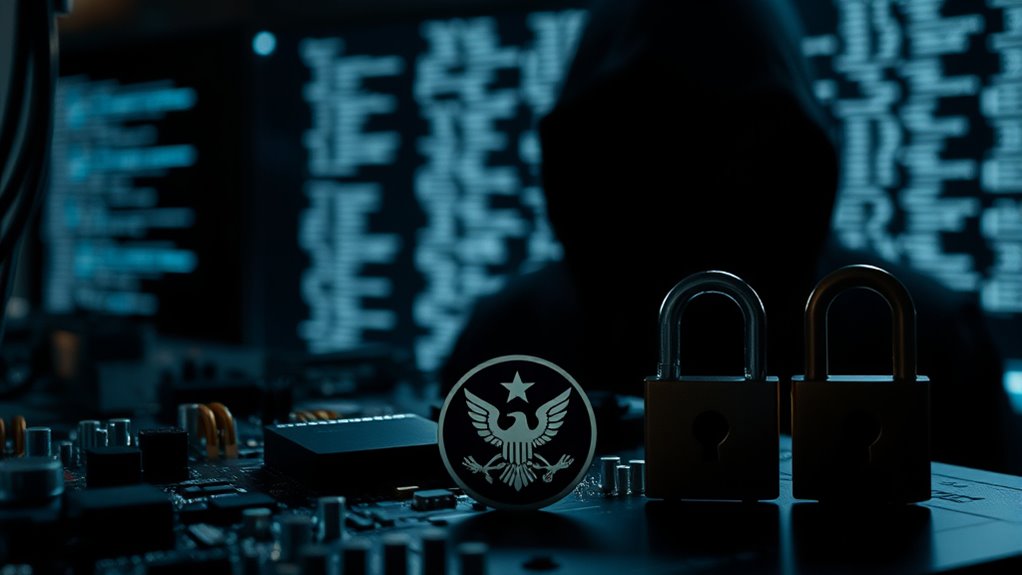China's UNC3886 group is currently targeting U.S. defense contractors, exploiting zero-day vulnerabilities to gain unauthorized access to their networks. This advanced threat is particularly focused on compromising critical infrastructure in Asia. Their tactics involve stealthy malware and custom implants that allow long-term persistence and intelligence gathering. With many attacks going undetected, it's crucial to strengthen your defenses. There's much more to uncover about their methods and implications for national security.
Key Takeaways
- UNC3886 targets U.S. defense contractors using zero-day vulnerabilities, notably CVE-2022-41328 and CVE-2023-20867, for unauthorized network access.
- The group exploits end-of-life Juniper Networks routers, providing persistent access and facilitating intelligence gathering and potential sabotage.
- UNC3886 employs sophisticated malware like TinyShell-based implants, enabling file transfers, interactive shells, and stealthy operations.
- Many attacks by UNC3886 remain undetected due to ineffective security monitoring and tampering with logs, posing significant risks to infrastructure.
- Regular security audits and timely patching of vulnerabilities are critical to defend against groups like UNC3886.

As the threat landscape evolves, the UNC3886 group has emerged as a significant player in cyber espionage, specifically targeting U.S. defense contractors and critical network infrastructure in Asia. You need to be aware that their focus on exploiting zero-day vulnerabilities in widely used devices, such as Fortinet and VMware products, poses a serious risk. For instance, vulnerabilities like CVE-2022-41328 and CVE-2023-20867 allow unauthorized access to networks, enabling long-term persistence that can go unnoticed.
UNC3886 employs sophisticated tactics to maintain this access. They use custom malware, particularly TinyShell-based implants, which come with various capabilities like file transfers, interactive shells, and SOCKS proxies. Their passive backdoors, such as irad and oemd, ensure their operations remain stealthy. They even tamper with logs to obscure their activities, making detection a considerable challenge. This level of customization helps them evade specific security measures, including those in Junos OS.
UNC3886 utilizes advanced malware and stealth tactics to maintain persistent access, complicating detection and response efforts.
You should also consider the implications of their targeting strategies. By compromising end-of-life Juniper Networks routers, UNC3886 gains control over critical network infrastructure. This not only provides persistent access but also allows for potential future disruptions. The lack of security monitoring around these compromised routers means that many attacks may go undetected, increasing the risk to various sectors reliant on this infrastructure.
The impact of UNC3886's activities is particularly concerning for U.S. defense contractors. Chinese actors are strategically infiltrating these networks for intelligence gathering and preparing for possible sabotage. Once inside, they often maintain access long after the initial breach, which poses ongoing risks to national security.
When you compare UNC3886 to other China-linked groups, like UNC5221 and UNC5337, you'll notice a pattern of exploiting vulnerabilities. While some groups focus on financial gain through cryptocurrency mining, UNC3886 is driven by strategic goals, emphasizing intelligence collection and disruption capabilities.
In this rapidly evolving cyber threat landscape, it's crucial for organizations, especially those in defense and critical infrastructure, to bolster their defenses against groups like UNC3886. Regular security audits, timely patching of vulnerabilities, and advanced monitoring solutions can help mitigate risks and protect sensitive information. The stakes are high, and awareness is the first step in safeguarding against these sophisticated cyber threats.
Frequently Asked Questions
What Are Zero-Day Exploits in Cybersecurity?
Zero-day exploits in cybersecurity refer to methods hackers use to attack systems through vulnerabilities that are unknown to vendors.
When you encounter a zero-day exploit, it means attackers can take advantage of these flaws before any patches are released. This makes them particularly dangerous, as they can lead to unauthorized access, data breaches, or system damage.
Staying informed and implementing strong security measures can help protect you from these threats.
How Can Organizations Protect Against Zero-Day Vulnerabilities?
To protect against zero-day vulnerabilities, you need a multi-faceted approach.
Start by monitoring vulnerabilities and vendor alerts. Implement advanced security measures like next-gen antivirus and intrusion detection systems.
Regularly update your software and conduct vulnerability scans to identify weaknesses.
Train your employees on cybersecurity best practices and establish policies based on the principle of least privilege.
Lastly, ensure you have a robust incident response plan ready to tackle any potential threats.
What Is the Significance of Unc3886's Actions?
You mightn't realize it, but every time a cyber threat like UNC3886 strikes, the stakes escalate.
Their actions highlight vulnerabilities in your network and expose critical weaknesses in defense systems. This isn't just a technical issue—it's about national security and your organization's integrity.
As they breach defenses, you must understand the gravity of their tactics and adapt quickly.
The implications of their exploits could reshape how you approach cybersecurity and risk management.
Are There Any Known Victims of These Zero-Day Exploits?
Yes, there are known victims of these zero-day exploits, particularly in the defense, telecommunication, and technology sectors.
Many organizations, including defense contractors and government agencies, have fallen prey to these attacks. The exploitation of vulnerabilities allows attackers to gain unauthorized access, leading to potential data breaches and espionage.
To protect your organization, it's crucial to keep your software updated and implement strong security measures to mitigate these risks.
How Does the U.S. Respond to Cyber Threats Like UNC3886?
Only 4% of defense contractors are fully prepared to meet DoD cybersecurity standards, highlighting a critical gap.
When faced with cyber threats, you'll see the U.S. employs a multi-faceted approach. This includes enhancing collaboration with agencies like CISA, which actively hunts for threats and fortifies infrastructure.
Conclusion
In light of UNC3886's recent zero-day exploits targeting U.S. defense contractors, it's clear that the stakes have never been higher. You can't afford to ignore these threats; they're a wake-up call for robust cybersecurity measures. As vulnerabilities are exploited, staying vigilant is crucial to safeguarding sensitive information. Remember, an ounce of prevention is worth a pound of cure. It's time to tighten security protocols and ensure you're not caught off guard in this escalating cyber landscape.









